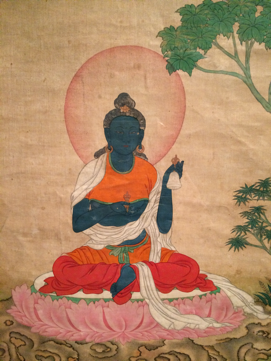
28 Jun The Inside Outside
This is one of the core principles of pilgrimage in the Vajrayāna context, the microcosm of the human body is reflected in and reflects the macrocosm. Through the purification of one’s own constituents, the inherent purity of the natural environment is revealed. As yogis and yoginis travel to the power places in a region, they practice cutting through habit, inhibition, and separation, revealing the inherently blissful purity of natural mind.
In building the stupas, practitioners undergo a similar alchemical process of purification and enrichment of their inner elements through their Vajrayāna practice and connection with the lineage. The stupa thus becomes a record and mirror of their own inner journey, much like Milarepa’s tower.
Power Places and Sacred Ground
Another aspect of pilgrimage in the Vajrayāna draws from the foundation myths of the Cakrasaṃvara tantra. This tantra tells the story of 24 power places in the Indian subcontinent which were populated by yogis and yoginis engaging in acts of sex and violence without the context of wisdom mind. The deity Cakrasaṃvara (“Supreme Bliss Buddha”) manifested in these locations and subdued their inhabitants with his splendor, and installed his own retinue in these places. These sites are divided into three sets of eight, correlating to the body, speech, and mind of the deity, and the three realms below, on, and above the earth. In the same way as many similar shamanic typologies across cultures, these three form a vision of totality that is the royal realm of the Cakrasaṃvara maṇḍala.
It is said that these 24 power places are present in every region, and in every city. They are also present in the body of every practitioner, and when a practitioner does pilgrimage in the context of this view, the subtle “vajra body” is purified and awakened as the inner and outer meet through the blissful and agonizing experiences of a tantric pilgrim. Pilgrimage becomes an embodied practice that uncovers and explores these dimensions, connecting the path of the individual to the whole, the interior to the exterior.
As is related by Ngawang Zangpo in Sacred Ground, his translation of Jamgön Kongtrul’s pilgrimage guide to Tsadra Rinchen Drak, the 24 (and 36) power places of India were transposed onto the Kham region of eastern Tibet in the late 19th Century. This was made possible through a revelation of Guru Rinpoche by the treasure revealer Chögyur Lingpa, which detailed each of the 24 (and 36) power places in Kham and their correlation. Tsadra (Literally, “Like Tsari”) was the location of Jamgön Kongtrul’s hermitage home, and was revealed as one of the 24 power places.
In his pilgrimage guide to the region, Jamgön Kongtrul details several circumambulation paths and practices for relating to the place and practice of pilgrimage there. Through this work and the treasure of Guru Rinpoche, Eastern Tibet was established as being every bit as sacred and powerful as the “holy land” of India. This allowed for the creation of a geographical basis for a local mythology to emerge, developing the region as sacred, powerful, and “central.” This provided the mythological matrix for the entire Nonsectarian Movement (Rimay), and the cultural renaissance that accompanied it. The people of the region were given a deeper context to ground their experience, to live and practice with the confidence that their environment was a maṇḍala, that they lived on sacred ground. At the same time that this revelation dissolved the notion that people needed to go far away to find sacred places, it intensified the relationship of the population with their environment, exploring the sacredness of their home through the practice of pilgrimage.
This historical precedent is very important for our project here in the Smoky Mountains. The land has been desecrated and exploited, its inhabitants forced away on the Trail of Tears, and with them the stories of the land have been destroyed and forgotten.
Without a sacred view of the land, the stories it holds cannot be told. A people that pretends to live without a mythology lives without an anchor or compass. Mythology begins with and grows out of the land. Without meaningful stories and rituals to honor the land, we can only attempt to fill this gap with materialist consumption and invest ourselves into further developing the land to facilitate that consumption. And so the cycle of desecration and exploitation feeds itself until only desolation remains, inside and out.
But perhaps by reinvigorating the land with a view of the sacred, and exploring the land in the context of pilgrimage, we can initiate a process and practice that can serve as the basis of personal meaning, cultural flourishing, and an embodied ecology.
Read More: Wandering in Exile


